
Stanisław I Leszczyński, also Anglicized and Latinized as Stanislaus I, was twice King of Poland and Grand Duke of Lithuania, and at various times Prince of Deux-Ponts, Duke of Bar and Duke of Lorraine.
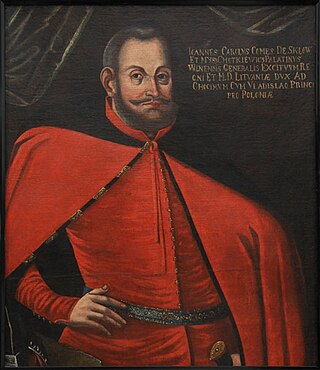
Jan Karol Chodkiewicz was a military commander of the Grand Ducal Lithuanian Army, who was from 1601 Field Hetman of Lithuania, and from 1605 Grand Hetman of Lithuania. He was one of the most prominent noblemen and military commanders of the Polish–Lithuanian Commonwealth of his era. His coat of arms was Chodkiewicz, as was his family name.

Stanisław II August, known also by his regnal Latin name Stanislaus II Augustus, and as Stanisław August Poniatowski, was King of Poland and Grand Duke of Lithuania from 1764 to 1795, and the last monarch of the Polish–Lithuanian Commonwealth.

Wojciech Żywny was a Czech-born Polish pianist, violinist, teacher and composer. He was Frédéric Chopin's first professional piano teacher.

Stanisław Wawrzyniec Staszic was a leading figure in the Polish Enlightenment: a Catholic priest, philosopher, geologist, writer, poet, translator and statesman. A physiocrat, monist, pan-Slavist and laissez-fairist, he supported many reforms in Poland. He is particularly remembered for his political writings during the "Great (Four-Year) Sejm" (1788–92) and for his large support towards the Constitution of 3 May 1791, adopted by that Sejm.

Count Jan Klemens Branicki was a Polish nobleman, magnate and Hetman, Field Crown Hetman of the Polish–Lithuanian Commonwealth between 1735 and 1752, and Great Crown Hetman between 1752 and 1771. One of the wealthiest Polish magnates in the 18th century, owner of 12 towns, 257 villages and 17 palaces. He was the last male representative of the Branicki family.

Count Roman Ignacy Potocki, generally known as Ignacy Potocki, was a Polish nobleman, member of the influential magnate Potocki family, owner of Klementowice and Olesin, a politician, statesman, writer, and office holder. He was the Marshal of the Permanent Council in 1778–1782, Grand Clerk of Lithuania from 1773, Court Marshal of Lithuania from 1783, Grand Marshal of Lithuania from 16 April 1791 to 1794.
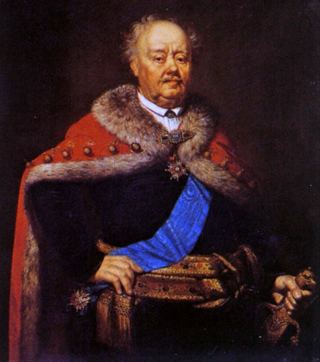
Franciszek Ksawery Branicki (1730–1819) was a Polish nobleman, magnate, French count, diplomat, politician, military commander, and one of the leaders of the Targowica Confederation. Many consider him to have been a traitor who participated with the Russians in the dismemberment of his nation.
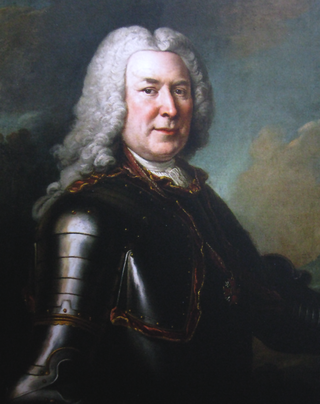
Prince Michał Fryderyk Czartoryski (1696–1775) was a Polish nobleman, the Duke of Klewań and Żuków, magnate, and Knight of the Order of the White Eagle. He headed Poland's Czartoryski "Familia".
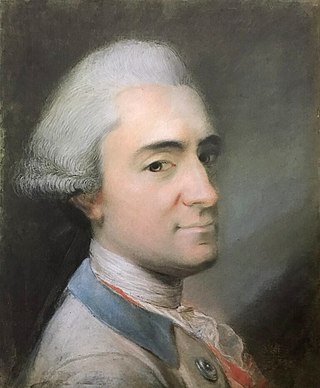
Prince Andrzej Poniatowski was a Polish nobleman (Szlachcic), General and Field Marshal.

The Great Sejm, also known as the Four-Year Sejm was a Sejm (parliament) of the Polish–Lithuanian Commonwealth that was held in Warsaw between 1788 and 1792. Its principal aim became to restore sovereignty to, and reform, the Commonwealth politically and economically.

Count Stanisław Szczęsny Feliks Potocki, of the Piława coat of arms, known as Szczęsny Potocki was a member of the Polish szlachta and a military commander of the forces of the Polish–Lithuanian Commonwealth and then Poland. Knight of the Order of the White Eagle, awarded in August 1775.

Franciszek Smuglewicz was a Polish-Lithuanian draughtsman and painter. Smuglewicz is considered a progenitor of Lithuanian art in the modern era. He was precursor of historicism in Polish painting. He was also a founder of Vilnius school of art, his most prominent students were Jan Rustem, Jan Krzysztof Damel, Gaspar Borowski and Józef Oleszkiewicz. His father Łukasz Smuglewicz and brother Antoni were also painters.

Józef Andrzej Załuski was a Polish Catholic priest, Bishop of Kiev, a sponsor of learning and culture, and a renowned bibliophile. A member of the Polish nobility (szlachta), bearing the hereditary Junosza coat-of-arms, he is most famous as co-founder of the Załuski Library, one of the largest 18th-century book collections in the world.

Yazlovets is a village in Chortkiv Raion, Ternopil Oblast, Ukraine. It is a Roman Catholic pilgrimage centre of local significance. The village belongs to the Buchach urban hromada. It lies on the Vilchivchik river, a tributary of the Strypa and is located 16 km south of Buchach and presently has around 600 inhabitants. From 1947-91, it was known as Yablunivka. Apart from the ruined fortifications, there is little sign now that in the 15th and 16th centuries this was a thriving trading centre, on major international mercantile routes between the Black Sea and Northern Europe, and host to multiple merchant families of diverse ethnicities and religions. It was an instance of a privately owned settlement, such as was Zamość in Poland. The city's square has been entirely obliterated.

The history of the Polish–Lithuanian Commonwealth (1648–1764) covers a period in the history of Poland and the Grand Duchy of Lithuania, from the time their joint state became the theater of wars and invasions fought on a great scale in the middle of the 17th century, to the time just before the election of Stanisław August Poniatowski, the last king of the Polish–Lithuanian Commonwealth.
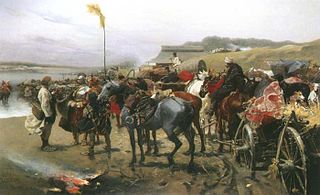
The Battle of Valkininkai took place on November 18, 1700, during the Lithuanian Civil War, between forces of the Sapieha family, led by Michał Franciszek Sapieha, and an anti-Sapieha coalition of Wiśniowiecki, Ogiński, Radziwiłł and Pac families and their supporters, led by Michał Serwacy Wiśniowiecki.
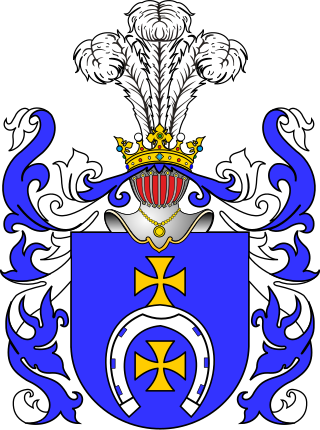
Aleksander Sielski (1610–1682) was a Polish noble. He bore the Lubicz coat of arms, as the envoy to the king, was the Castellan of Gniezno and Łęczyca, Chamberlain of Poznań and 74th Marshal of Sejm in the Polish–Lithuanian Commonwealth (1652).
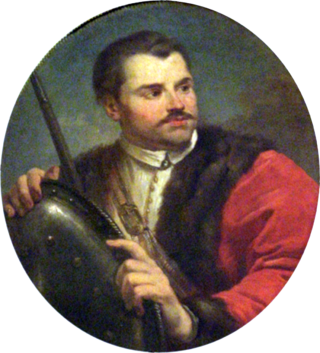
Prince Roman Fedorovich Sanguszko was a soldier and statesman of the Grand Duchy of Lithuania. He served as governor (voivode) of Bracław and was hetman of Lithuania from 1567 until his death. He fought at the Battle of Ula in 1564 and belonged to the nesuhoizhskoy branch of the House of Sanguszko.




















